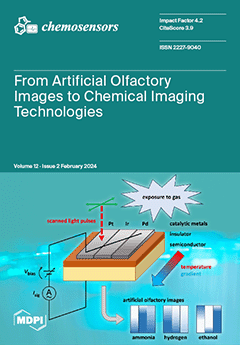This study reports, for the first time, the utilization of two-dimensional (2D) tellurium (Te) nanosheets for the efficient nonenzymatic detection of hydrogen peroxide (H
2O
2). H
2O
2 acts as a pivotal biomarker with widespread applications across environmental, biological,
[...] Read more.
This study reports, for the first time, the utilization of two-dimensional (2D) tellurium (Te) nanosheets for the efficient nonenzymatic detection of hydrogen peroxide (H
2O
2). H
2O
2 acts as a pivotal biomarker with widespread applications across environmental, biological, industrial, and food processing domains. However, an excessive accumulation of H
2O
2 in the body poses a severe threat to human life. Consequently, the imperative need for a selective, sensitive, and cost-effective sensing platform for H
2O
2 detection has gained paramount significance. Employing a low-cost and straightforward hydrothermal method, Te nanosheets were synthesized to address the escalating demand for a reliable detection platform. The as-synthesized Te nanosheets are characterized through Raman spectroscopy and atomic force microscopy techniques. The electrochemical performance of the Te nanosheets integrated onto a glassy carbon (Te-GC) electrode was thoroughly investigated using cyclic voltammetry, differential pulse voltammetry, and chronoamperometry. The experiments were designed to evaluate the response of the Te-GC electrode in the presence and absence of H
2O
2, alongside its performance in the detection of other pertinent interfering analytes. The sensor shows a limit of detection of 0.47 µM and a sensitivity of 27.2 µA µM
−1 cm
−2 towards H
2O
2. The outcomes of this study demonstrate the efficacy of Te nanosheets as a promising material for nonenzymatic H
2O
2 detection in urine samples. The simplicity and cost-effectiveness of the hydrothermal synthesis process, coupled with the notable electrochemical performance of the Te/GC electrode, highlight the potential of Te nanosheets in the development of a robust sensing platform. This research contributes to the ongoing efforts to enhance our capabilities in monitoring and detecting H
2O
2, fostering advancements in environmental, biomedical, and industrial applications.
Full article





